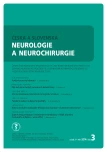Selective Denervation of the Carpus to Manage Arthritis Involvement of a Wrist
Authors:
J. Pilný 1,2; J. Štědrý 2; A. Švarc 2; E. Ehler 1,3; I. Čižmář 4; I. Holubová 1; M. Macková 1
Authors‘ workplace:
Fakulta medicínských studií, Univerzita Pardubice
1; Ortopedické oddělení, Pardubická krajská nemocnice, a. s.
2; Neurologická klinika Pardubické krajské nemocnice, a. s.
3; Traumatologické oddělení, FN Olomouc
4
Published in:
Cesk Slov Neurol N 2014; 77/110(3): 359-361
Category:
Short Communication
Overview
Introduction:
Arthritis of the wrist is a frequent consequence of inadequately treated wrist injuries. A range of methods has been published for pain reduction but these frequently limit, or completely eliminate, movement. Selective denervation of the wrist is method that can be used to reduce wrist pain.
Patients and methods:
The authors present a set of 31 wrists selectively denervatied by resection of nervus interosseus anterior and posterior. The file was preoperatively evaluated by Distability of the Arm, Shoulder and Hand (DASH) score and the same group of patients was evaluated two years after the surgery. Patient satisfaction was evaluated on a scale of 1–5.
Results:
Preoperative mean on the DASH score was 43.52 points and postoperative 24 points. Therefore, patients improved by a mean of 19.52 points. On the 1–5 scale, nine (29%) patients reported 1 (very satisfied), 12 (39%) reported 2 (satisfied), six (19%) reported 3 (neither satisfied nor dissatisfied), four (13%) marked 4 (unhappy) and none used 5 (very dissatisfied).
Discussion:
Selective denervation of the wrist is a method that can reduce pain with no effect on motion in a large proportion of patients. Its advantages include its technical simplicity and an opportunity to still use other treatments if selective denervation of the wrist does not improve the condition.
The authors declare they have no potential conflicts of interest concerning drugs, products, or services used in the study.
The Editorial Board declares that the manuscript met the ICMJE “uniform requirements” for biomedical papers.
Sources
1. Camitz H. Die deformierende Huftgelenksathritis und speziell ihre Behandlung. Acta Orthop Scand 1933; 4: 193– 213.
2. Tavernier L, Truchet P. La section des branches articulairesdu nerve obturateur dans le traitement de l’arthritechronique de la hanche. Rev Orthop 1942; 28: 62– 68.
3. Wilhelm A. Zur Innervation der Gelenke der oberen Extremitat. Z Anat. Entwicklungsgesch 1958; 120: 331– 371.
4. Wilhelm A. Die Gelenkdenervation und hire anatomischen Grundlagen. Hefte zur Unfallheilk 1966; 86: 1– 109.
5. Ferreres A, Foucher G, Suso S. Extensive denervation of the wrist. Tech Hand Up Extrem Surg 2002; 6(1): 36– 41.
6. Berger RA. Partial denervation of the wrist: a new approach. Tech Hand Up Extrem Surg 1998; 2(1): 25– 35.
7. Fibir A. Hodnocení výsledků v chirurgii ruky z pohledu pacienta. Ortopedie 2011; 5(2): 84– 87.
8. Cizmar I, Svizenska I, Masek M, Bujok T, Ira D. Parciální denervace karpu řešená excizí interosseálních nervů z dorzálního přístupu. Acta Chir Orthop Traumatol Cech 2005; 72(1): 47– 51.
9. Drac P, Pilny J, Manak P, Ira D, Cizmar I. Proximální karpektomie v léčbě poúrazových degenerativních změn zápěstního kloubu. Acta Chir Orthop Traumatol Cech 2009; 76(1): 25– 29.
10. Gay A, Harbst K, Hansen DK, Laskowski ER, Berger RA, Kaufman KR. Effect of partial wrist denervation on wrist kinesthesia: wrist denervation does not impair proprioception. J Hand Surg Am 2011; 36(11): 1774– 1779. doi: 10.1016/ j.jhsa.2011.07.027.
11. Storey PA, Lindau T, Jansen V, Woodbridge S, Bainbridge LC, Burke FD. Wrist denervation in isolation: a prospective outcome study with patient selection by wrist blockade. Hand Surg 2011; 16(3): 251– 257.
12. Hohendorff B, Mühldorfer‑ Fodor M, Kalb K,von Schoonhoven J, Prommersberger KJ. Long‑term results following denervation of the wrist. Unfallchirurg 2012; 115(4): 343– 352. doi: 10.1007/ s00113-011- 2131- 6.
Labels
Paediatric neurology Neurosurgery NeurologyArticle was published in
Czech and Slovak Neurology and Neurosurgery

2014 Issue 3
- Metamizole vs. Tramadol in Postoperative Analgesia
- Memantine in Dementia Therapy – Current Findings and Possible Future Applications
- Memantine Eases Daily Life for Patients and Caregivers
- Metamizole at a Glance and in Practice – Effective Non-Opioid Analgesic for All Ages
- Advances in the Treatment of Myasthenia Gravis on the Horizon
Most read in this issue
- Functional Movement Disorders
- An Overview of Less Common Primary Headaches
- Neurobiological Hypotheses in Panic Disorder
- Sacral Nerve Neuromodulation in the Treatment of Faecal Incontinence
